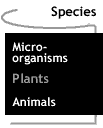
Wetlands:
Species--Plants
Plants play a very important role in the wetlands ecosystem: they are
primary producers. They trap and store sunlight in the form of chemical energy. This energy is then used by the animals that eat the plants, and the microorganisms that break down dead plant material.
Another important role of wetlands plants is to produce oxygen. In addition to producing oxygen, plants also need oxygen in order to carry out certain life processes. One way in which plants obtain oxygen is by absorbing it from the soil through their roots. Since wetlands soils are typically saturated with water, they have very little pore space in which to hold oxygen. Wetlands plants have evolved many specialized adaptations in order to survive in these low-oxygen ecosystems. For example, while the root systems of
terrestrial, or dry land, plants extend deep into the soil to obtain water, the root systems of wetlands plants are often quite shallow. This adaptation allows the plant to take advantage of the fact that the top few inches of wetlands soil may be drier and therefore contain more oxygen than the deeper soil. Some wetlands plants even grow their roots up into the air to access more oxygen.
Another way in which plants obtain oxygen is by absorbing it from the air through small holes in their leaves. These holes are called stomata and they are typically located on the underside of the plants' leaves. However, the leaves of some wetlands plants rest directly on the water's surface. These plants have developed stomata on the upper surface of their leaves where the stomata are more likely to be directly exposed to the air.
Common types of wetland plants
include:
emergents plants that are rooted underwater in the soil, but extend above the water's surface; for example, cattails (see left), pickerelweed, arrowhead, and sedges. Photo: Cattails. Photo courtesy of William Boyer.
submergents plants that live almost entirely underwater; for example, milfoil, pondweeds, and water celery.
floaters plants that float freely on the water's surface; for example, duckweed and water hyacinth.
trees large, woody plants that have one main stem or trunk with many branches; for example, cypress, willow, red maple, and green ash.
For more images and information on some of these wetlands plants, visit University of Florida Aquatic, Wetland and Invasive Plant Information Retrieval System
Overview
..|..
Species
..|..
Functions..
..|..
Management
Microorganisms
/ Plants / Animals
Glossary
..|..
Related
Links
..|..
References
|..PBL
Model
Home ..|.. Teacher Pages ..|.. Modules & Activities
HTML code by Chris
Kreger
Maintained by ETE Team
Last updated
April 28, 2005
Some images © 2004 www.clipart.com
Privacy Statement and Copyright © 1997-2004 by Wheeling Jesuit University/NASA-supported Classroom of the Future. All rights reserved.
Center for Educational Technologies, Circuit Board/Apple graphic logo, and COTF Classroom of the Future logo are registered trademarks of Wheeling Jesuit University.

